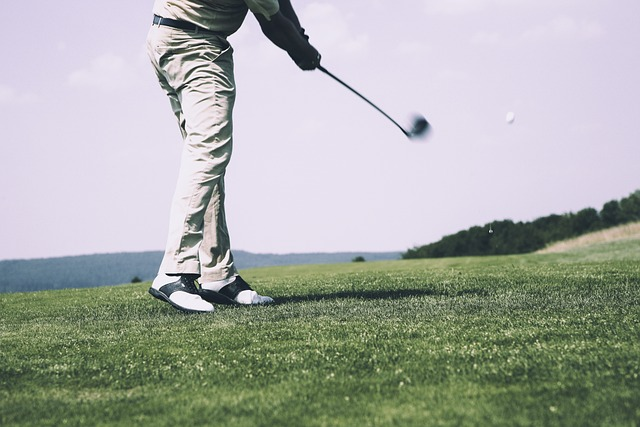Content Summary
Golf is a sport that can be enjoyed by people of all ages and skill levels.
The Basic Golf Swing: A step-by-step guide to the golf swing, from address to follow through.
The golf swing is a complex motion, but it can be broken down into simple steps. This step-by-step guide will teach you the basics of a golf swing, from address to follow through.
Stance
1. Start by taking your stance. Your feet should be shoulder-width apart, and your weight should be evenly distributed.

Grip
2. From there, take your grip on the club. There are a few different ways to do this, but the most important thing is to make sure that you're comfortable.

3. Once you've got your grip, it's time to address the ball. This simply means getting into position to hit it. Again, there are a few different ways to do this, but the most important thing is to be comfortable and in control.
Hips

4. When you're ready to hit the ball, take a deep breath, and then swing the club back. You should rotate your hips as you do this.
5. When you reach the top of your backswing, begin to move forward into the downswing.
Head

6. As you swing forward, it's important to keep your head still and focused on the target. You don't want to look up when you're swinging, because that will cause you to lift your head and stop your swing.
Wrists

7. As you swing forward, the club should travel in a straight arc on the same plane. You want to make sure your wrists stay relaxed, and that you don't try to lift the club up over your head or fling the club through the ball.
8. As you swing down, the club should strike the back of the ball and take a divot after contact. This is called hitting down on the ball.
9. When you make contact with the ball, you want to keep your wrists relaxed and let your hands guide the club through impact with a slight draw.
Arms

10. After you hit the ball, your left arm should extend out away from your body, and then come back toward your body. Your right arm should extend away from your body after impact, and then return to your body as well.
11. If you are striking the ball properly, it should feel as if the ball was a wad of butter. Hence the term "the shot felt like butter".
The ball should fly straight and far. If not, you have probably made a fundamental swing error. Again, don't worry if this doesn't make sense right now. You can check out more swing tips here.
The Importance of a Good Grip: Why grip is important in the golf swing, and how to achieve a good grip.
Golfers often underestimate the importance of the golf swing basics such as a good grip. A proper grip is essential to creating a powerful and consistent golf swing.
There are many different ways to grip a golf club, but there are a few basic principles that all good grips share.
To achieve a good grip, start by holding the club in your left hand (for right-handed golfers). Place your thumb on the side of the club closest to you, and position your four fingers so they wrap around the club comfortably. Your grip should be firm but not too tight.
Once you have positioned your left hand, place your right hand on the club so that it overlaps your left hand. Again, make sure that your grip is firm but not too tight.
Experiment with different grips until you find one that feels comfortable and gives you the most control over your shots.
The Backswing: How to execute a proper backswing to set yourself up for success on the downswing.
When it comes to the golf basic swing, the backswing is just as important as the downswing. A proper backswing will set you up for success on the downswing and help you hit the ball with more power and accuracy. Here are a few tips on how to execute a proper backswing:
1. Take your stance with the clubhead behind the ball. Look down and visualize your swing path as you take your backswing.
2. Keep your head up while your eyes are focused on the ball (some golfers make the mistake of dropping their head down which affects your backswing and downswing). This will help you keep a level swing plane as you take your backswing.
3. Pull your arms back at an angle of forty five degrees from your body. This will help you create more power when the club starts its downswing.
4. Use a straight left arm that is parallel to the ground as you take your backswing. Move your weight onto the right side but do not sway, simply move your right hip back and feel pressure in your right heel. This will help you keep your swing on plane.
5. Keep your arms as relaxed as possible. This will help create more clubhead speed at impact.
The Downswing: Tips for executing a powerful and accurate downswing.
When it comes to improving your golf game, nailing the perfect downswing is key. But for many players, this can be easier said than done. Here are a few tips to help you execute a powerful and accurate downswing:
1. Start by shifting your weight back to your front side but do not sway. Feel your left hip move back out of the way as your body and arms follow down. This will help you generate more power as you swing through the ball.
2. As you start your downswing, keep your clubface square to the ball, (a neutral grip will help with this). This will ensure that you make solid contact with the ball.
3. Be sure to follow through with your swing. Do not stop your forward motion after impact. Keep moving through to the finish with your chest pointing at or just left of the target. This will help you generate more distance and accuracy on your shots.
The Follow Through: Completing the golf swing with a proper follow through.
A proper follow through is the key to completing the golf swing. Without it, the golf swing will be incomplete and will not generate the desired results.
There are three main components to a proper follow through: 1) complete extension of the arms; 2) full rotation of the torso; and 3) balanced finish.
1) Complete extension of the arms: The arms should be extended fully at the end of the swing, with the club pointing in the direction of the target. This will ensure that all the power generated by the swing is transferred to the ball.
2) Full rotation of the torso: The torso should rotate fully during the follow through, so that both shoulders are facing the target. This will ensure that your body is in alignment with your arms and club, and that you are able to transfer all your power to the ball.
FAQ's
How should a beginner swing a golf swing?
There's no one perfect way to swing a golf club, but there are some basics that all beginners should keep in mind.
First, you want to make sure you have a good grip on the club. Second, you want to take a smooth, controlled swing.
Third, you want to follow through with your swing and finish strong. And finally, remember to relax and have fun!
What is the simplest golf swing?
There is no single "simplest" golf swing, as there are many different ways to swing a golf club. However, some basic principles of a good golf swing include keeping the arms and wrists relaxed, maintaining a smooth tempo, and avoiding excessive movement of the head or upper body.
What are the 3 keys to the golf swing?
The three keys to the golf swing are tempo, balance, and follow through.
Conclusion
The golf basic swing is a simple, yet effective way to improve your game. By following the steps outlined in this article, you can develop a consistent and powerful swing that will help you lower your scores and have more fun on the course. So get out there and start practicing your golf basic swing today!
Thank you for visiting and we hope to see you back soon!






